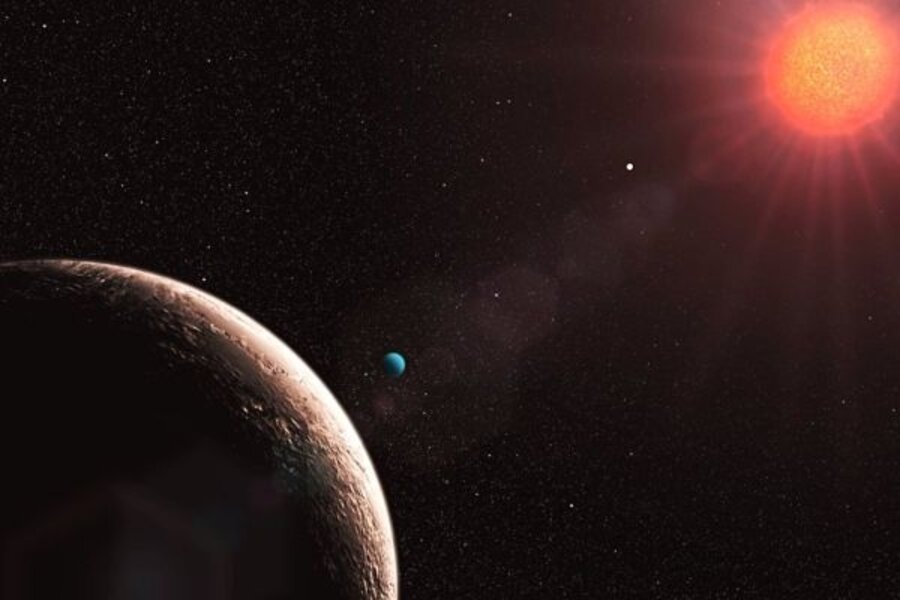Potential 'water world' may be just another ice ball
Loading...
Habitable zones for planets in a solar system are a bit like baseball strike zones: A lot can depend on the umpire.
On Monday, astronomers in Europe announced a two-fer around the same star, Gliese 581: a planet with a mass purt-near close to that of Earth; and a revised orbit for another planet orbiting the same star that puts the object (six times Earth's mass) "firmly" in the star's habitable zone. (You can read more about it here.) The first has withstood additional scrutiny. The second? Maybe not so much.
This morning, emails were heading back and forth across the Atlantic from a pair of like-minded planetary scientists. The gist: How can these folks announcing the discovery say that the planet is "firmly" in the habitable zone?
The discussion highlighted just how complex it can be to identify a habitable zone.
The thumbnail description -- a region of space where the planet is not too hot, but not too cold to give liquid water a chance to pool on the planet's surface -- is a broad-brush definition. The devil is in the details, which is where Gliese 581d, the potential "water world," comes in.
First, take the concepts of distance and heat. If you've ever huddled by a campfire, you know the feeling. Sit too close, it's uncomfortable; sit too far, and it's freezing, although the flickering light is a nice touch.
Where's the fire?
Your ability to stay warm depends, first, on a combination of your distance from the fire and on the size of the fire.
Gliese 581d's "sun" is about one-third the sun's mass. Its furnace burns less fiercely than the sun's.
Accounting for that difference, the water-world wanna-be receives far less than incoming radiation than Earth does from the sun. How much less?
Pardon the jargon here, but at the top of the atmosphere, Earth receives 1,367 watts worth of radiation per square meter; only about 40 percent makes it through the atmosphere to reach the surface. Based on the European team's orbital data, the amount of radiation reaching 581d is only about 370 watts per square meter.
So calculates Ray Pierrehumbert, a University of Chicago scientist who studies planetary atmospheres, including Earth's. He points out that Mars, in its earliest days, was getting 412 watts per square meter from the sun. So Gliese 581d is getting significantly less radiation from its "sun" than did a young Mars.
Wearing layers?
But if you've moved away from that fire while wearing layers, you'll retain some of that warmth (for a bit anyway). So your ability to stay warm also depends on the ability of your Polartec camping clothes -- your atmosphere -- to retain what heat you do receive.
Which brings us to another factor in determining a habitable zone: the existence, composition, and thickness of a planet's atmosphere. For that, there is precious little known about Gliese 581d.
Some scientists suggest it could have an atmosphere laced with carbon dioxide, a greenhouse gas. But it would take an boatload of the stuff to do a warming job fit for a water world -- if the CO2 could remain a gas.
Dr. Pierrehumbert explained in an email exchange that you can't rely on greenhouse gases like carbon dioxide or water vapor to trap heat on a planet like 581d. It's so far away from its "campfire" that even if its surface could absorb all the radiation it receives, the surface temperature would average about 100 degrees below zero Fahrenheit.
The CO2 and water vapor would condense, fall out of the atmosphere, and remain as ice on the surface. That process is likely to be the one that drove condensation of CO2 and water vapor on Mars in its early years, he says.
Since 581d has far more mass than Mars, one would expect it to cling to any atmosphere more tightly than Mars did. But that added gravity also would pull condensed CO2 out of the atmosphere more quickly. Likewise with condensed water vapor.
With the information available at the moment, Gliese 581d is most likely an ice ball throughout its orbit. In the end, Pierrehumbert explains, until scientists resolve questions that still surround conditions on an early Mars, it's a bit early to place 581d "firmly" in its host star's habitable zone.
"One could make some statement that there is the bare possibility -- if something happens there that is analogous to various proposals for warming an early Mars," he writes. "But it's not time to start beaming old Star Trek episodes to 581!"





